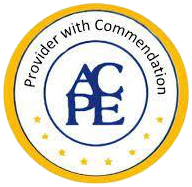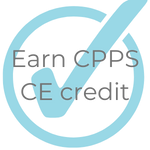Medication Safety Certificate
Overview
The Medication Safety Certificate’s comprehensive curriculum is designed to provide participants with the knowledge and skills necessary to lead and engage in efforts to improve medication safety. The following medication safety principles are addressed:
- Stages of the medication use process
- Foundations of a medication safety culture including principles of high reliability organizations, learning health systems, and just culture
- Medication safety leadership
- Applying quality improvement methodologies to medication safety projects
- Human factors engineering
- System-based causes of medication errors
- Proactive and reactive identification of medication safety risks
- Risk reduction strategies
- Medication safety technology
- Investigating and analyzing medication errors
- Disclosure of medication errors and supporting second victims
- Planning and implementing medication safety initiatives
This program is accredited for continuing education for pharmacists and pharmacy technicians. This activity meets the criteria of the Certification Board for Professionals in Patient Safety for CPPS continuing education (CE) credit hours.
Medication Safety Certificate Requirement
Once a learner has completed the educational curriculum, they will have the opportunity to complete an online comprehensive exam. Once the learner completes the exam (minimum 80% passing rate; unlimited attempts permitted), they will earn the professional certificate.
Accreditation
Accreditation for Pharmacists and Pharmacy Technicians

The American Society of Health-System Pharmacists is accredited by the Accreditation Council for Pharmacy Education as a provider of continuing pharmacy education with Commendation.
Certified Professionals in Patient Safety (CPPS)
This activity meets the criteria of the Certification Board for Professionals in Patient Safety for up to 26.5 CPPS CE hours.
Target Audience
This certificate is intended for pharmacists and pharmacy technicians. The learning modules meet the continuing education (CE) criteria of the Certification Board for Professionals in Patient Safety (CPPS).
Course Modules
|
Learning Activity |
ACPE Number |
Contact Hours |
|
Medication Safety: An Introduction |
0204-0000-25-773-H05-P&T |
2.0 |
|
Foundations of a Medication Safety Culture |
0204-0000-25-774-H05-P&T |
3.0 |
|
Quality Improvement Fundamentals |
0204-0000-25-775-H05-P&T |
3.25 |
|
Human Factors Engineering |
0204-0000-25-776-H05-P&T |
4.0 |
|
Interface Between Technology and Safety |
0204-0000-25-777-H05-P&T |
2.25 |
|
Proactive Identification of Medication Risk |
0204-0000-25-778-H05-P&T |
1.75 |
|
Reactive Identification of Medication Risk |
0204-0000-25-779-H05-P&T |
3.5 |
|
Investigation and Analysis of Medication Errors |
0204-0000-25-780-H05-P&T |
1.5 |
|
Reducing Risk of System-Based Causes of Error & Applying Risk Reduction Strategies |
0204-0000-25-781-H05-P&T |
2.25 |
|
Disclosure of Medication Errors and Caring for Second Victims |
0204-0000-25-782-H05-P&T | 1.0 |
|
Medication Safety Improvement Planning and Implementation |
0204-0000-25-783-H05-P&T | 2.0 |
|
→ Final Assessment: (80% passing score required) |
||
Learning Objectives
Medication Safety: An Introduction
ACPE: 0204-0000-25-773-H05-P&T
Application-based
2 contact hours
Learning Objectives:
- Discuss the most common causes and types of medication errors.
- Differentiate between active and latent failures.
- Identify system-based causes of medication errors.
- Describe the major areas of responsibility and essential skills of an effective medication safety leader in a complex healthcare environment.
- Recommend methods used to influence and engage key stakeholders in medication safety initiatives.
- Explain effective conflict management techniques used to build successful teams.
- Identify important findings from a medication error event that require further investigation.
Foundations of a Medication Safety Culture
ACPE: 0204-0000-25-774-H05-P&T
Application-based
3 contact hours
Learning Objectives:
- Explain the fundamental principles and concepts characteristic of high reliability organizations.
- Describe how high-reliability practices drive safe and effective care in the complex medication use system.
- Describe how the core principles of a learning health system support a culture committed to patient safety.
- Define a just culture and the meaning of a shared accountability.
- Explain why a just culture is essential to improving safety.
- Describe the types of human behaviors associated with errors and the appropriate responses to each in a just culture.
- Explain the role of staff surveys about patient safety in efforts to develop a just culture.
- Describe action steps that facilitate implementation of a just culture.
- Identify risk reduction strategies by their degree of leverage, i.e., low, medium, and high.
- Explain the disadvantages associated with implementing strategies without proven effectiveness.
- Explain how an algorithm should be used by interprofessional teams to analyze events, risks, and both system and individual accountability.
- Apply a just culture algorithm to staff behaviors following an event to determine a fair response.
Quality Improvement Fundamentals
ACPE: 0204-0000-25-775-H05-P&T
Application-based
3.25 contact hours
Learning Objectives:
- Identify the most common quality improvement methodologies.
- Describe each phase of the plan-do-check-act cycle.
- Explain the principles of the Lean quality improvement methodology.
- Select Lean tools that can be used by interprofessional teams to improve medication safety.
- Explain how “people development” and “deference to expertise” lead to successful change cultures.
- Explain concepts related to Lean methodology, including Kaizen event and DMAIC, and the application of Lean improvement tools to the medication use system.
- Describe strategies for planning and implementing successful improvement projects.
Human Factors Engineering
ACPE: 0204-0000-25-776-H05-P&T
Application-based
4 contact hours
Learning Objectives:
- Explain the basics of human factors engineering concepts and methods.
- Apply human factors engineering concepts when analyzing medication safety events.
- Differentiate the human factors methods of usability testing and heuristic evaluation.
- Describe how heuristic evaluation and usability testing can be used to improve medication safety.
Interface Between Technology and Safety
ACPE: 0204-0000-25-777-H05-P&T
Application-based
2.25 contact hours
Learning Objectives:
- Explain specific technology solutions available to address safety concerns throughout the stages of the medication use process.
- Summarize the benefits, improvements, and errors associated with technology solutions.
- Explain the need for a structured system, processes, and resources necessary to promote optimization of technologies in support of medication safety.
- Apply effective clinical decision support in computerized prescriber order entry and electronic prescribing (e-prescribing).
- Identify three challenges related to the implementation of technology within the medication use process.
- Evaluate the benefits and challenges associated with the implementation of technologies designed to support safe medication administration.
- Analyze potential failure modes in technology implementation and maintenance.
- Summarize the importance of using data to evaluate if implemented technology is achieving safety benefits.
Proactive Identification of Medication Risk
ACPE: 0204-0000-25-778-H05-P&T
Application-based
1.75 contact hours
Learning Objectives:
- Use external resources to prospectively evaluate medication safety risks.
- Identify the components of failure mode and effects analysis (FMEA).
- Explain the strengths and limitations of proactive risk identification, such as FMEA.
- Apply failure modes and effects analysis (FMEA) for risk identification.
Reactive Identification of Medication Risk
ACPE: 0204-0000-25-779-H05-P&T
Application-based
3.5 contact hours
Learning Objectives:
- Identify the principles of medication safety risk identification.
- Compare strengths and limitations of methods of reactive medication safety risk identification.
- Explain the types of technology data that can be used to identify medication safety risks.
Investigation and Analysis of Medication Errors
ACPE: 0204-0000-25-780-H05-P&T
Application-based
1.5 contact hours
Learning Objectives:
- Describe a systematic approach to the identification, investigation, and assessment of medication events including methods for managing a successful institutional event reporting program.
- Explain the relationship between adverse drug events, adverse drug reactions, and medication errors.
- Contrast examples of skill-based, rule-based, and knowledge-based errors.
- Differentiate algorithms and tools available to assist in system-based investigation, assessment, and outcome classification of medication events.
- Explain the major steps and components of a root cause analysis (RCA) process.
- Compare alternative methodologies available for conducting cause analyses.
- Identify regulatory expectations for event management to protect patients, improve systems, and prevent harm.
Reducing Risk of System-Based Causes of Error & Applying Risk Reduction Strategies
ACPE: 0204-0000-25-781-H05-P&T
Application-based
2.25 contact hours
Learning Objectives:
- Explain the concept of risk reduction strategies in preventing and reducing system failures.
- Explain and provide examples of the four principles of risk reduction.
- Identify risk reduction strategies by their degree of leverage, i.e., low, medium, and high.
- Summarize the advantages and disadvantages of each type of risk reduction strategy.
- Give an example of each type of risk reduction strategy.
- Apply effective risk reduction strategies to medication error events.
- Identify latent failures in the medication use system that contribute to a medication error event.
- Identify the key system element from a medication error event with the greatest potential for error prevention.
- Select strategies to prevent medication error events from occurring in other organizations.
Disclosure of Medication Errors and Caring for Second Victims
ACPE: 0204-0000-25-782-H05-P&T
Application-based
1 contact hour
Learning Objectives:
- Explain the importance of honest disclosures and sincere apologies to patients and family members following an adverse event.
- Describe the role of the medication safety leader in the disclosure of medication errors.
- Define second victim phenomenon.
- Identify the six predictable phases of the second victim recovery process.
- Explain three ways healthcare organizations can provide peer support to caregivers following an adverse event.
Medication Safety Improvement Planning and Implementation
ACPE: 0204-0000-25-783-H05-P&T
Application-based
2 contact hours
Learning Objectives:
- Explain the following about medication safety plans:
- Resources available to assist the interprofessional team in the development of a medication safety plan;
- The importance of integrating a medication safety plan into an organization's strategic plan; and
- Potential challenges associated with developing and executing a medication safety plan.
- Explain Kotter's eight steps for leading change and how they can be applied to medication safety initiatives.
- Discuss factors that promote the diffusion of innovation and spread of changes.
- Identify three key factors that are considered during prioritization of risk reduction strategies.
- Explain the elements required for successful implementation of medication safety improvements including, but not limited to, a call to action, identifying key stakeholders, and tracking the progress of improvement projects.
- Describe the RACI model for managing stakeholder engagement.
- Describe the use of A3 and Gantt charts for planning and tracking improvement projects.
- Explain important considerations related to going live with medication safety initiatives including, but not limited to, staff education, collecting feedback, and communicating and celebrating improvements.
- Describe methods for measuring and communicating medication safety improvements including types of metrics, and dashboards and scorecards.
Faculty
Kelly Besco, PharmD, FISMP, CPPS
Advisor, High Reliability Organization (HRO)
OhioHealth
Columbus, Ohio
Melissa Carlson, PharmD, BCPS, FMSHP
Director of Medication Safety
M Health Fairview
Minneapolis, Minnesota
Anna Legreid Dopp, PharmD, CPHQ
Senior Director, Government Relations
American Society of Health-System Pharmacists
Bethesda, Maryland
Lynn Eschenbacher, PharmD, MBA, FASHP
National Director of Pharmacy Operations
Ascension, The Resource Group
St. Louis, Missouri
Jamie Gomes, PharmD, BCPS
Pharmacy Supervisor
Children’s Hospital of Philadelphia
Philadelphia, Pennsylvania
John Hertig, PharmD, MS, CPPS, FASHP, FFIP
Founder
Hertig Healthcare Advising, LLC
Indianapolis, Indiana
Adjunct Assistant Professor
Purdue University
West Lafayette, Indiana
Jamie Irizarry, MS, RN, BSN
Sr. Enterprise Improvement Advisor
Children’s Hospital of Philadelphia
Philadelphia, Pennsylvania
Patricia Kienle, BS Pharm, MPA, BCSCP, FASHP
Director, Accreditation and Medication Safety
Cardinal Health
Wilkes-Barre, Pennsylvania
Emily Messing, PharmD, BCPS
Medication Safety Officer
Dana-Farber Cancer Institute
Boston, Massachusetts
Nicole Mollenkopf, PharmD, MBA, BCPS, BCPPS, FNAP
Assistant Professor, Director of Interprofessional Education
John Hopkins School of Nursing
Patient Safety Specialist
Armstrong Institute for Patient Safety and Quality
Baltimore, Maryland
Natasha Nicol, PharmD, FASHP
Director, Global Patient Safety Affairs
Cardinal Health
Pawleys Island, South Carolina
Elizabeth Rebo, PharmD, MBA, CPPS
Executive Director, Medication Safety
Kaiser Permanente
Los Angeles, California
Sarah Stephens, PharmD, CPPS, FASHP
Enterprise Pharmacy Initiatives Manager
Cedars-Sinai
Los Angeles, California
Andrew Stivers, PharmD
Director - Medication Safety, Quality, and Regulatory
Dana-Farber Cancer Institute
Boston, Massachusetts
Elizabeth Wade, PharmD, CPPS, FASHP
Director of Medication Compliance, Quality, and Safety
Dartmouth Health
Manchester, New Hampshire
DeeAnn Wedemeyer Oleson, PharmD, MHA, BCGP, CPHQ, CPPS
Director, Scientific Projects, Special Projects
American Society of Health-System Pharmacists
Bethesda, Maryland
Relevant Financial Relationship Disclosure
In accordance with our accreditor’s Standards of Integrity and Independence in Accredited Continuing Education, ASHP requires that all individuals in control of content disclose all financial relationships with ineligible companies. An individual has a relevant financial relationship if they have had a financial relationship with an ineligible company in any dollar amount in the past 24 months and the educational content that the individual controls is related to the business lines or products of the ineligible company.
An ineligible company is any entity producing, marketing, re-selling, or distributing health care goods or services consumed by, or used on, patients. The presence or absence of relevant financial relationships will be disclosed to the activity audience.
The following persons in control of this activity’s content have relevant financial relationships:
- Jamie Irizarry, MS, RN, BSN: B. Braun Medical Inc. United States - consultant
All other persons in control of content do not have any relevant financial relationships with an ineligible company.
As defined by the Standards of Integrity and Independence in Accredited Continuing Education definition of ineligible company. All relevant financial relationships have been mitigated prior to the CE activity.
Methods and CE Requirements
Each activity consists of audio, video, and/or PDFs and evaluations. Learners must review all content and complete the evaluations to receive continuing pharmacy education credit for each activity.
Follow the prompts to claim, view, or print the statement of credit within 60 days after completing the activity.
Important Note – ACPE 60 Day Deadline:
Per ACPE requirements, CPE credit must be claimed within 60 days of being earned. To verify that you have completed the required steps and to ensure your credits have been reported to CPE Monitor, check your NABP eProfile account to validate that your credits were transferred successfully before the ACPE 60-day deadline. After the 60-day deadline, ASHP will no longer be able to award credit for this activity.
The ASHP Professional Certificates SM educational product line contains learning activities that are ACPE-accredited knowledge and application-based continuing education. This is not an ACPE Certificate Program. Upon successful completion of the activities, the learner will be able to download an ASHP Professional Certificate.


